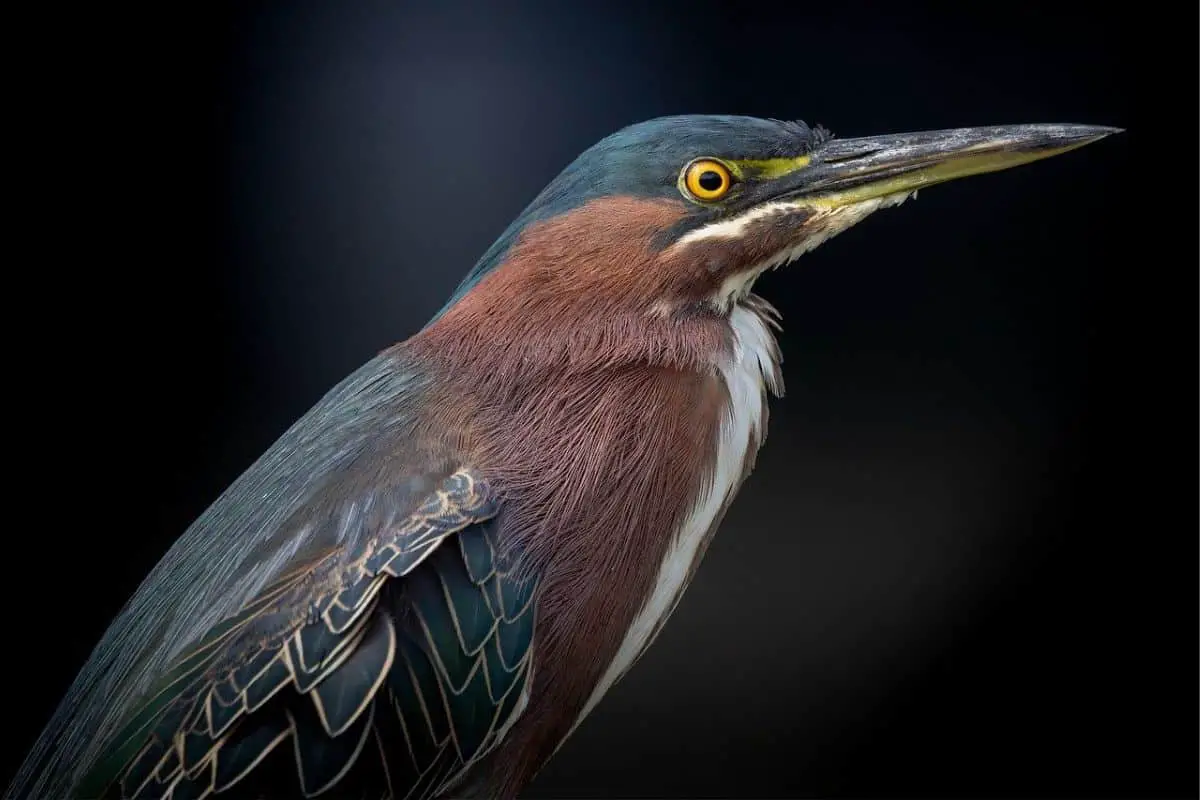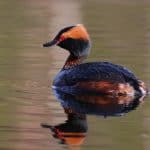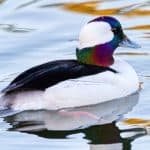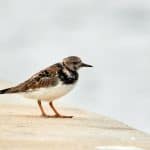Common Name: Green Heron
Scientific Name: (Butorides virescens)| Size | Diet | Range in Hawaii | Status in Hawaii |
|---|---|---|---|
| 16 in. - 18 in. | small aquatic creatures, crustaceans and insects | Kaua'i, O'ahu, Maui, and Big Island | Least Concern |
The Green Heron (Butorides virescens) is a small and striking bird species that is known for its distinctive green and blue plumage and sharp bill. With its keen eyesight and stealthy hunting abilities, this heron is a fascinating sight in its natural habitat.
Although it is not a native species to Hawaii, Green Herons have been spotted occasionally on the islands as non-breeding visitors or vagrants, making for a rare and exciting sighting for birdwatchers. In this article, we’ll explore the fascinating world of the Green Heron and learn more about its unexpected presence in Hawaii.
Green Heron
Appearance

The Green Heron is a small heron species with distinctive features. It has a compact body measuring approximately 16 to 18 inches (40 to 46 centimeters) in length. The bird’s plumage consists of a predominantly dark greenish-blue coloration, which gives it its common name. The upperparts are glossy green, while the underparts are chestnut in color.
The Green Heron has a relatively short neck and a thick, dagger-like bill that is yellowish or orange in color. Its head is topped with a black cap, and it has a white throat and chin. The bird’s legs are long and yellowish-green, allowing it to navigate through marshy habitats and shallow waters with ease.
When observed in flight, the Green Heron displays broad wings and a characteristic hunched posture. It often holds its neck in an S-shape, providing a distinct silhouette.
Diet
The Green Heron is an opportunistic carnivore with a diverse diet. It primarily feeds on small aquatic creatures, particularly fish, which make up a significant portion of its diet.
The heron employs various hunting techniques to capture its prey, such as standing still and patiently waiting for fish to approach within striking distance. It may also stalk its prey or engage in rapid lunges to catch fish swimming nearby.
In addition to fish, the Green Heron feeds on a variety of other aquatic organisms. It readily consumes amphibians like frogs and tadpoles, as well as small crustaceans such as crabs and crayfish. Insects, spiders, small reptiles, and even small mammals are also known to be part of its diet.
The heron’s foraging behavior is versatile, as it can adapt to different wetland habitats. It may search for food along the edges of marshes, ponds, streams, or even in flooded fields and rice paddies. The Green Heron’s ability to exploit a wide range of prey items contributes to its survival and success in diverse ecosystems.
Nesting
The Green Heron exhibits interesting nesting behavior. They typically build their nests in dense vegetation near or over water, choosing locations such as marshes, swamps, or the edges of ponds and streams. The nests are often constructed in trees or shrubs, usually within a few feet of the water’s edge.
The nests of Green Herons are relatively small, consisting of a platform made of sticks and twigs. The birds may line the nest with softer materials like leaves, moss, or feathers for added comfort. Both the male and female contribute to the construction of the nest.
Green Herons are solitary nesters, meaning they usually do not nest in colonies like some other heron species. They are protective of their nesting sites and may aggressively defend them from intruders, including other herons.
A typical clutch of Green Heron eggs consists of 3 to 5 pale blue or greenish-blue eggs. Both parents take turns incubating the eggs, which usually hatch after approximately 19 to 21 days.
The chicks are initially helpless and rely on their parents for food and protection. They grow rapidly and develop their flight feathers in about three weeks.
Once the young herons are capable of flight, they leave the nest but continue to depend on their parents for several more weeks until they become independent. The nesting season of Green Herons usually spans from spring to early summer, aligning with the availability of food and favorable breeding conditions.
Behavior

The Green Heron exhibits fascinating behaviors that contribute to its survival and success in wetland environments. These behaviors showcase the heron’s adaptability and resourcefulness.
One notable behavior of the Green Heron is its hunting strategy. It employs patience and stealth when stalking its prey. The heron can often be observed standing motionless near the water’s edge, waiting for an opportunity to strike. With lightning-fast reflexes, it lunges forward to snatch fish, amphibians, or other small creatures swimming nearby.
Green Herons also display tool-using behavior. They are known to utilize bait to attract fish. They may drop objects like twigs or insects onto the water’s surface, imitating the movement of prey.
When curious fish investigate, the heron seizes the opportunity to catch them. This remarkable skill demonstrates the heron’s problem-solving abilities and adaptability in securing its food.
In addition to hunting, the Green Heron engages in various courtship displays during the breeding season. Males often perform elaborate flight displays, showcasing their wingbeats and calling loudly to attract a mate. Once pairs form, they engage in mutual preening and other bonding behaviors.
Despite being solitary nesters, Green Herons are not entirely antisocial. They can be observed in loose groups or aggregations during migration or in areas with abundant food resources. However, they are known to be territorial around their nesting sites and may exhibit aggressive behaviors towards intruders.
When threatened, Green Herons display defensive behaviors. They may stretch their necks upward, fluff their feathers, and emit harsh calls to ward off potential predators or rivals. They may also engage in distraction displays, feigning injury or vulnerability to divert attention away from their nest or young.
Habitat
Green Herons prefer habitats with dense vegetation near water sources such as marshes, swamps, ponds, streams, and the edges of rivers. They can adapt to both freshwater and brackish water environments. The availability of suitable perching sites, such as trees or shrubs, is important for their nesting and hunting behaviors.
These herons are well-adapted to navigating through dense vegetation, using their long legs and sharp claws to move gracefully in wetland habitats. They are often found in areas with overhanging branches or vegetation that provides cover and perches for hunting. Their plumage coloration, which includes shades of green and brown, allows them to blend effectively with the surrounding vegetation, providing camouflage while hunting and nesting.
The Green Heron’s habitat choice is closely linked to the availability of their primary food sources, which include fish, amphibians, invertebrates, and small reptiles. Wetlands offer abundant prey populations, making them ideal for the heron’s foraging needs.
Due to their adaptability, Green Herons can also be found in urban and suburban areas with suitable wetland habitats, including parks, ponds, and even backyard gardens with water features.
Range
The Green Heron is a bird species known for its range in temperate North and Central America, with migration extending south to Panama. While typically not found in Hawaii, there have been occasional sightings of Green Herons in the Hawaiian Islands. These sightings have been reported on multiple islands, including Kaua’i, O’ahu, Maui, and Big Island.
The exact number of recorded sightings is estimated to be around 8-9 individuals. The presence of Green Herons in Hawaii is considered unusual, as they are typically not found in the Northwestern Hawaiian Islands or other areas of the North Pacific.
Conservation Status
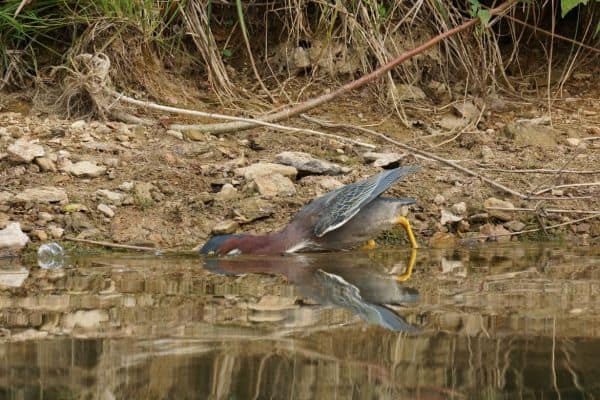
The conservation status of the Green Heron is currently categorized as Least Concern by the International Union for Conservation of Nature (IUCN). This classification indicates that the species is widespread and abundant, with no imminent threat of extinction.
However, it is important to note that wetland degradation and habitat loss pose potential threats to the species. Human activities such as urbanization, agriculture, and drainage of wetlands can lead to habitat fragmentation and destruction, reducing the availability of suitable nesting and foraging sites for Green Herons.
Interesting Facts
1. Clever fishers
Green Herons are known for their ingenious fishing techniques. They have been observed using bait to attract fish. By dropping twigs, insects, or other small objects onto the water’s surface, they mimic the movement of prey, luring curious fish within striking distance.
2. Tool users
Green Herons are one of the few bird species known to use tools. They have been observed using a variety of objects, such as feathers or insects, to help attract fish or manipulate their prey.
3. Camouflage experts
These herons have excellent camouflage. Their plumage, consisting of shades of green, brown, and blue, allows them to blend seamlessly into the surrounding vegetation, providing effective camouflage while hunting or nesting.
4. Neck stretching display
During courtship and territorial displays, Green Herons exhibit a distinctive behavior of extending and retracting their necks in an S-shape, creating an elegant and elongated silhouette.
5. Agile hunters
Green Herons are skilled hunters, using their sharp beaks and quick reflexes to snatch prey from the water’s surface or catch it with precise strikes. Their ability to navigate through dense vegetation and perch on branches aids them in their hunting endeavors.
Frequently Asked Questions
1. Are Green Herons social birds?
Green Herons are mostly solitary birds, but they can be found in loose groups or aggregations during migration or in areas with abundant food resources. They tend to be territorial around their nesting sites and may exhibit aggressive behaviors towards intruders.
2. Are Green Herons vocal?
Yes, Green Herons are vocal birds and produce various calls. They emit harsh squawks or series of kowk-kowk-kowk calls when alarmed or threatened. Males may also produce distinct advertising calls during courtship displays.
3. How long do Green Herons live?
Green Herons have an average lifespan of around 7 to 15 years in the wild. However, some individuals have been known to live up to 20 years or more under favorable conditions.
4. Are Green Herons monogamous?
Green Herons are generally monogamous during the breeding season. Mating pairs form and engage in courtship displays, mutual preening, and other bonding behaviors. However, they typically do not form lifelong pair bonds and may find new mates in subsequent breeding seasons.
